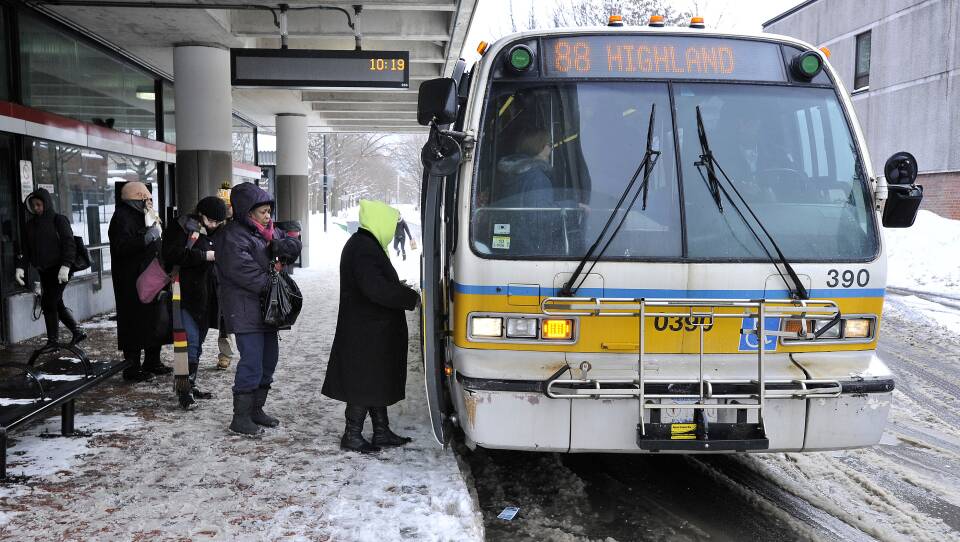Joanne Daniels-Finegold sometimes carries a shovel on the back of her wheelchair because she’s never quite sure what conditions she’ll find at bus stops.
Sometimes, she finds ice and heaps of snow blocking her path to a bus shelter, which leaves her with a few unfortunate choices to get where she needs to go: drive her wheelchair into the street near traffic, or dig out the bus stop herself.
The MBTA is responsible for removing snow and ice from all MBTA properties. But when it comes to the thousands of bus stops across the Boston area, which are mostly located on municipal sidewalks, it’s a shared responsibility. The MBTA clears snow from 15 of its busiest routes, but the duty is less clear for the more than 100 other routes. Those bus stops often fall under different snow removal ordinances, and clearing them may be the responsibility of the state, city, town, private property owner or business owner.
Advocates say this lack of uniformity can lead to snow and ice not being properly removed at bus stops, and disabled riders don’t know who to contact to complain.
“And it’s not just a problem for people who are older, or people who are not steady on their feet. It’s a problem for people who are pushing strollers ... it’s a problem for someone rolling luggage along,” Daniels-Finegold said. “We need to recognize the fact and deal with it, frankly.”
Daniels-Finegold, who is 71 and lives in Braintree, was the lead plaintiff in a class-action lawsuit that resulted in extensive improvements to accessibility on the MBTA. The 2006 settlement called for the MBTA to develop a plan to coordinate with cities and towns to make sure bus stops are accessible, including plans for snow removal.

Yet still, each winter, disabled riders say they come face-to-face with frustrating conditions.
“There’s something inequitable here. A lot of people who use buses are low-income people, [they] need public transportation,” said Taramattie Doucette, a senior attorney at Greater Boston Legal Services, which represented the plaintiffs in the MBTA accessibility case. Collaboration is key, she says.
“What has to happen is that there needs to be a coordinated effort, between municipalities, the MBTA, even MassDOT,” Doucette said. “People would think it falls on the shoulders of the MBTA. But we say no, it’s a shared responsibility. Everyone has to take part in this.”
The MBTA’s bus service encompasses roughly 8,000 stops across more than 50 different cities and towns.
“Nine out of ten times when we’re talking about a bus stop, we’re talking about a city sidewalk. We really rely on the municipalities to clear snow and ice in order to make sure that our services are safe and accessible for everybody,” said Laura Brelsford, assistant general manager of MBTA Department of System-Wide Accessibility, which was created in 2007 as part of the settlement. “The volume of city sidewalks that we would be touching is simply not feasible for an agency the size of the MBTA.”
Brelsford said, over the past year, they’ve been developing a plan to better communicate with municipalities about accessibility and clarify responsibilities when it comes to snow removal. In January, the MBTA hired a new director of government affairs to oversee municipal engagement.
“We very much recognize that resources are limited,” Brelsford said. “I think that is one of the major barriers to making real progress on this. I think the reason often that cities and towns point back to us [the MBTA] is because they don’t have the resources to take on additional snow-removal responsibilities.”
Ralph DeCicco, chair and ADA coordinator at the Revere Commission on Disabilities, notes that each city pays the MBTA to have service there. Revere says it takes proactive steps each year to improve snow removal.
“When it’s pointed out that the cities and towns should be cleaning the bus stops, I take that to heart,” he said. “Not only not only as a resident, but also as a person with disabilities, because ... cities and towns are limited, as to where they can spread out and what they have to do, especially in the winter time.”
Ten years ago, the MBTA heard concerns about winter conditions and took responsibility for snow removal on those 15 key bus routes and the Silver Line, which is about 10% of bus service.
In Brookline, the 66 is one of those key routes.
“For the 66, the MBTA does a good job of getting out there at some point in a storm event to remove snow from the actual stops and a sort of reasonable area around the stop,” said Abby Swaine, an accessibility advocate whose son is paraplegic and uses a manual wheelchair.
But for the other stops in Brookline on non-key routes, snow removal is split between the town and property owners. Even if the stops themselves are well cleared, the curb cuts, corners and actual loading area aren’t always, Swaine has observed.
“They [the MBTA] really aren’t responsible for a large area around the shelter. And so the rider’s at the mercy of any other entity that’s responsible for the rest of the sidewalk network to get to the shelter,” Swaine said.
For example, Swaine calls bus route 60, which goes along Massachusetts Route 9, a “triple whammy” for accessibility in winter.
“It's not a key bus route, so the MBTA isn't responsible for it. It's not Brookline's responsibility, so they say, because it's along a state highway. And MassDOT Highway Division is not famous for caring about sidewalks. So what happens is nobody clears that,” she said.

Conditions can also vary in Somerville, according to Tom Gilbert, another plaintiff in the accessibility lawsuit. Gilbert is legally blind, and like Daniels-Finegold would also sometimes have to resort to shoveling bus stops himself. He says that snow removal has gotten better over the years, and that Somerville has started to remove snow completely from bus stops after large storms.
But inconsistencies remain, inconsistencies he often sees on Western Avenue. On one side of the street, he’s observed that a private business — a bank — does a good job at clearing bus stops, sidewalks and wheelchair ramps. But that’s not the case for the stop right across the street, on a sidewalk with a housing authority and several small businesses.
“Often on my side of the street, it kind of gets ignored and [it’s] inadequate,” Gilbert said. “For people like myself and people that have walkers and use wheelchairs, it’s very dangerous and you’re bound to slip, you know, on a slanted driveway.”
Some advocates are calling for legislation to clarify responsibilities and penalties around snow removal.
“At a state level in particular, we need something that just maps out the uniform requirements for who has to shovel. When do they have to shovel? How often do they have to shovel? Those things are needed from the top down,” Doucette said.
Without action and collaboration, Daniels-Finegold said, the problem won’t be fixed.
“Snow removal is perennial. We live in New England. It's not going anywhere,” she said.








